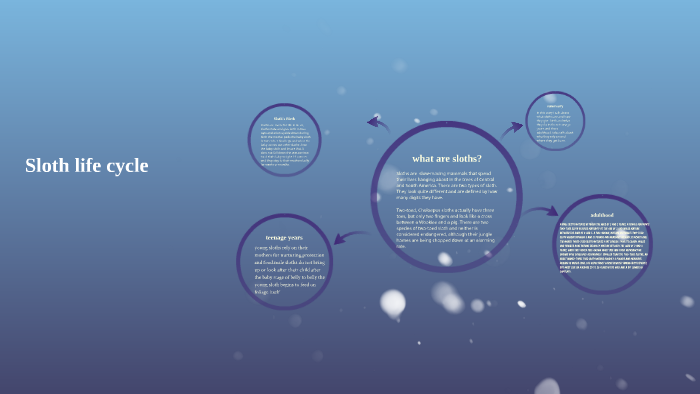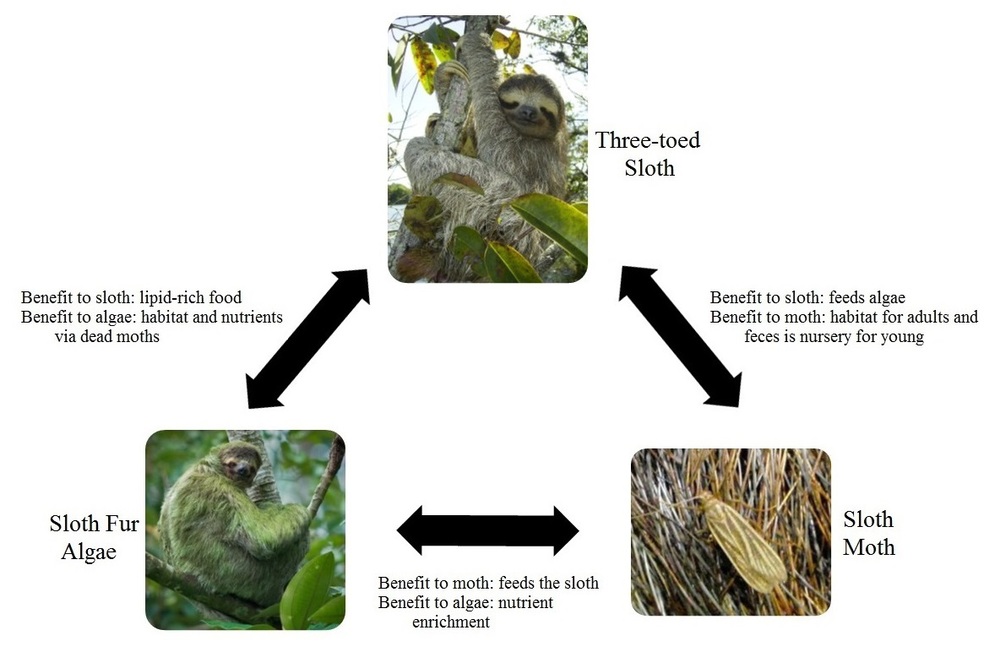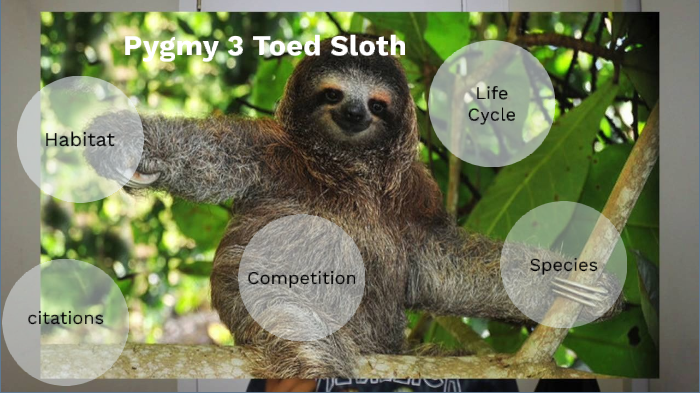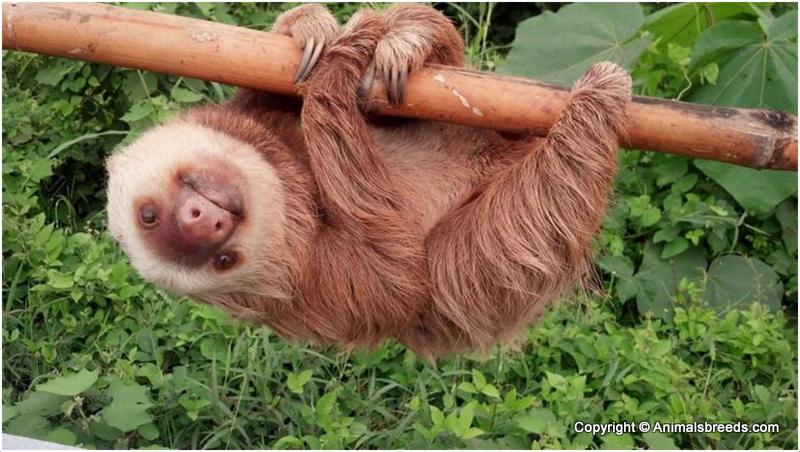A Sloths Life Cycle
Sloths are mammals found in South and Central America. They hang to the tree branches with their long claws. They survive on leaves. Their long claws make it difficult for them to walk on the ground. Hence, they spend a lot of time on trees.
The common ancestor of the two existing sloth genera dates to about 28 million years ago, with similarities between the two- and three- toed sloths an example of convergent evolution to an arboreal lifestyle, 'one of the most striking examples of convergent evolution known among mammals'. The ancient Xenarthra included a much greater variety of species, with a wider distribution, than those of.
There are two kinds of sloths; Two-toed and three-toed. They share most of the features but vary in size.
This is what the life of a sloth is like every day. Sloths are tropical mammals, or warm-blooded animals that live in tropical (hot and moist all year) regions. There are two types of sloths: the. Life cycle of a sloth - SlOTH'S sloths have a gestation of 10-12 months. They typically have one baby at a time, and the baby will cling to its mother for about 6 months, but stays near its mother for about 1 year. Sloths live for about 20 years, but in captivity they can live into their thirties.
It's a good thing sloths don't have to go to school. They'd never make it on time. These drowsy tree-dwellers sleep up to 20 hours a day! And even when they are awake, they barely move at all. In fact, they're so incredibly sluggish, algae actually grows on their fur. Specifically, sloths appear to promote pyralid moth infestation by descending to the base of the tree to defecate and assisting the life cycle of moths 16,19, even in the face of heightened predation risk and significant energetic costs. Moths in the fur of sloths, in turn, act as a portal for nutrients, linking the ecosystem within sloth.
Table of Contents
- 11 Sloths Characteristics
Sloths Facts and Information
- Sloths are the slowest animals in the world.
- Algae grow on the fur of sloths. The green color of algae make sloths hide from predators in the trees.
- Sloths can climb only six to eight feet per minute.
- Sloths are wonderful swimmers. Sloths drop themselves into the water from the branches.
- Sloths do not shiver when it is cold as their body has only 25% muscle.
- The claws of sloths offer them protection against predators.
- The Scientific Name of the Sloths is Choloepus Hoffmanni
Sloths Diet

Sloths eat leaves which are hard to digest. The leaves are digested slowly in their four-part digestive system. A sloth takes a month to digest a meal of food. Their diet is not nutritious and they do not derive much energy from it.
Sloths are considered folivores as they rely on tender shoots, leaves and buds. Two-toed sloths have been found to eat small reptiles, birds and insects as per few documentations.
A Sloths Life Cycle
Sloths Habitat


Sloths are most commonly found in the rain forests of south and central America. They curl into a ball while sleeping. They also hang from the tree branches. Sloths are not known for activities.
They spend most of their time eating and sleeping. These leave trees only to swim. Sloths that have been kept captive sleep for fifteen to twenty hours per day. This leaves them with little time to indulge in social activities. Sloths prefer leading solo lives.
Sloths Appearance
Sloths have flat, short head, short snout, big eyes, long legs, tiny ears and curved claws. There are two species of sloths. These have either two or three claws. These have sad-looking eyes, stubby tails and roundish heads. Two toed sloths are bigger than the three toed ones. Three toed sloths seem as if they are smiling because of their facial coloring. Sloths can turn their head around because of the two extra vertebrae in the neck.
Behavior
Sloths spend a lot of time hanging from the branches of trees. They sleep, mate and eat in the trees. Their curved, strong claws help them in hanging from the branches of trees. Male sloths are shy, solitary animals. Female sloths indulge in little bit of socializing. They sleep entire day and are active during the night time. Sloths do not move until it is necessary. They defecate and urinate once a week and for this they come to the ground.
Sloths Lifespan
The life expectancy of a sloth varies based on the species. Most of the sloths live for 20 to 30 years. In captivity, there can survive for a longer time. The lifespan of a median sloth is 15 years.
Predators
Humans, the harpy eagle and jaguar are the main predators of sloths. Poachers and electrical lines were responsible for death of sloths in Costa Rica. A sloth can protect itself from camouflage and because of the slow movement. These features let them disappear in the canopy of the rainforest.
Sloths Breeding
Sloth mate and give birth to young ones in trees. Courting begins when a female sloth screams to inform the males in the area that she is ready for mating. Males put up a fight by hanging from the tree branches. They paw at other sloths to be the winner. Sloths just have one offspring at a time.


Sloth Life Cycle Facts
The gestation period is five to six months. The babies cling to their mothers for several weeks after their birth. They stay with their mothers for up to four years. The mating season is usually during the spring season. In South America, sloths mate during July-November. In Central America, the sloths mate during February-May.
Sloths Lifestyle
Sloths live in dense forests. They spend a lot of time in trees. They climb down once in a week to the base of the tree. They bury the feces in the vicinity of the trees they reside in. Their feces act as a wonderful fertilizer for the trees they reside in. This is because their stool breaks down quite easily.
Images, Pics, Photos and Pictures of Sloths :
Sloths Grooming
Sloths do not groom themselves. They have a dense coat of fur which grows algae. They have a greenish tinge during the rainy season because of the growth of algae. Sloths belly houses several micro bacteria for breaking down the food that they eat and thereby promote digestion.
The digestion process of a sloth is quite slow. It takes about a month for a slot to digest a meal. The metabolism of a sloth is very low. This is why the nutrients extracted from the sloths is slow and the low energy level probably the reason why they are sluggish.
Sloths Characteristics
A Sloth Bear's Life Cycle
- Sloths have greenish and thick brown coat of fur.
- They hand from trees with their claws.
- The only defense means for a sloth is its claw.
- A sloth that has been cornered tries to swipe the attackers to scare or wound them.
- Sloths move slowly and hence do not attract attention.
- They are vulnerable only during their visits to the ground that happens once in a week.
- Colonies of algae grow on sloths. This acts as a camouflage and source of nutrients when sloths try to lick their fur.
- In sloths, the hair grows in the opposite direction from other mammals. This is because they spend a lot of time with their legs above their bodies hanging from the tree branches. protection is offered to the sloths with their hair growing from extremities.
- Sloths are four legged animals
- Sloths land on the ground in upright position or else they spend most of the time up-side down hanging from tree branches
- Sloths are home to several creatures such as moths and beetles.
- Sloths are excellent swimmers.
- Sloths have multiple compartment stomachs.
Related Posts
Different Species Of Sloths
- Aye Aye
The aye-aye is known as Daubentonia madagascariensis. It is a rodent like animal that can be found in Madagascar. Its features are similar to that of a rodent. The aye-aye…
- Red Panda
Red Pandas are popularly known as firefox, lesser panda, red bear cat and red cat bear. The size of these pandas is almost the same of a housecat, though their…